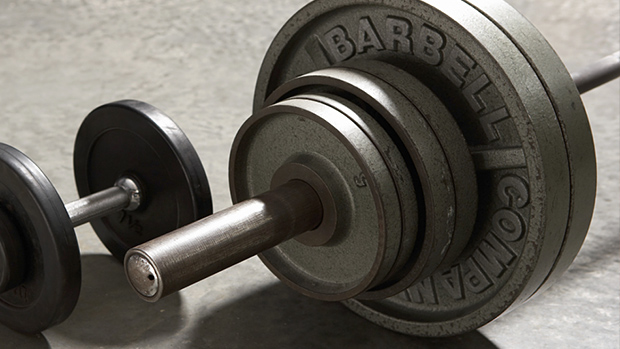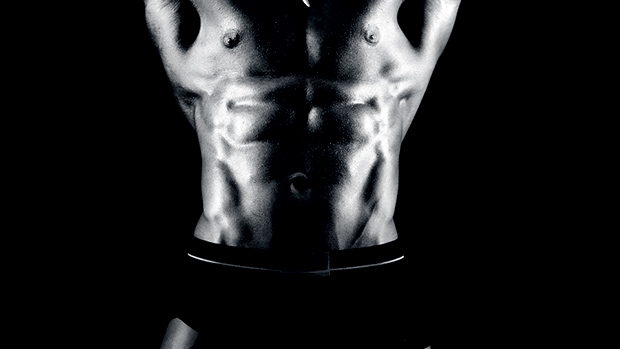Many moons ago, when I was first getting into lifting, I worked at a popular supplement store in a local shopping mall.
It was an okay gig for an 18 year-old dude. There was a very well-known gym nearby, so having in-shape gym bunnies and guys with comic book proportions come into the store provided regular motivation. It was also my introduction to the unbelievably stereotypical meathead.
Like most supplement stores, we stocked the most popular training magazines. I wound up developing a serious muscle magazine addiction, reading and re-reading each of the five magazines that came out every month when I wasn't busy selling Saw Palmetto and Horny Goat Weed to creepy old guys.
If there's a bright side to it all, it's that I can take a look back and realize what I've learned since then. For one, bodybuilding magazines can be super-confusing for a young guy trying to cobble together his own training routine.
Magazine #1 talked about a monster chest workout, and I sure wanted a monster chest, but Magazine #4 talked about a killer superset back and chest workout, and that sounded great too, so maybe I'd try that instead.
Point is, every month I was getting pulled in so many different directions and it was just too confusing. This guy says to train triceps after back, that guy says train tris with biceps, and some other guy said train them after chest and shoulders. Who's right?
Well, hindsight being what it is, I now know that they were all right. At the end of the day, when the noise is tuned out and bodybuilding is pared down to its fundamentals, it's really as simple as "train all your muscles and they'll get bigger." Seriously. (Yeah, yeah, as long as you eat right, of course. Nutrition is a whole 'nother animal.)
To give better direction to today's beginners, or even for more experienced guys looking for an effective change in routine, let's take a look at a method of organizing a bodybuilding split so that every muscle group, from the top of your traps to the bottom of your calves, gets trained intensely and effectively.
The idea behind this style of program design is straightforward – divide the body into parts, directly train each body part with at least one exercise per session, build big muscles, get kinda strong all over, feel like a winner. Let's see how it all comes together.

Eleven Ways to Sunday
How exactly did I end up dividing the 600-plus muscles of this gorgeous machine called the human body into just 11 parts ready for training?
Well, they're split up into three basic categories – primary, secondary, and detail – based, essentially, on real estate. The muscles that can, would, and should take up the largest space on your body when developed are considered "primary," working down from there.
It might not be the most scientific breakdown, but it's practical for our purposes here. Depending on how many days per week you're training, each workout will train body parts from one or more of those groups.
- Primary: Back, chest, quadriceps
- Secondary: Hamstrings, shoulders, triceps, biceps
- Detail: Abdominals, traps, forearms, calves
It's crucial to note that the "primary" and "secondary" designations used here are not necessarily related to the muscle's functional roles as primary or secondary movers in any given exercise.
That's a factor in exercise selection and other program details we'll discuss later on, but the terms are only being used here simply as a way to make them easier to arrange.
Similarly, don't take the term "detail" to imply that those body parts don't warrant significant attention. Ab training, in particular, is absolutely important from a strength, performance, and physique standpoint. So for now, don't read too much into calling it "detail work."
On one hand, it's a priority issue and about time/effort management – forearms simply don't warrant the same training intensity or volume as quads, for example – but on the other hand, those in the "detail" group are what most people either neglect completely, train infrequently or, worse, work halfheartedly.
You could try to argue that back training should be broken down further, but don't bother. If we separated it into something like "upper back," "lats," and "lower back," this whole thing would be a 13-bodypart split and that's just bad mojo.
And really, as long as you're smart enough to include at least one kind of row and at least one kind of pulldown or pull-up, along with other stuff, you're pretty much covering the entire back.
So, remember that rule – since we'll be training back once a week, a back workout without a row and a pulldown is not a back workout. (We'll cover a few more general rules in a bit.)
Why Hit the Splits?
As competitive bodybuilding was gaining momentum in the mid to late-1950s, many bodybuilders started to get away from full body workouts and lean more towards various body part splits.
That's also, not coincidentally, when the bodybuilding mags of the time started running some of the first specialization articles. "Two Weeks to Titanic Triceps!" "Shoulder Shocker for Shirt-Busting Growth!"
Splitting the body into parts allowed a higher volume and/or intensity-per-body part per workout, which was made possible (at least somewhat) by the anabolic "helpers" that were appearing in the locker rooms around the same time.
However, it also reflected the increased focus on bodybuilding while distancing itself from the old "train for strength and size will follow" mindset that was popular in previous years when bodybuilding judges awarded points for "athletic ability" (most often based on the then-three Olympic lifts) as well as points for muscularity, symmetry, and posing.
In any case, you can be sure that the hundreds of thousands of bodybuilders over the last six decades have experimented with every possible combination of "this on this day with these and that on that day with a few of those." In the 21st century, there are no new training splits, but you can be damn sure there are plenty you haven't tried or thought of yet.
Hopefully you're not seeing this approach to training as an invitation to over-analysis. "Okay, hamstrings today. Gotta' make sure I'm doing the one-leg toes-in standing curl for the semitendinosus and lying toes-out curls for the semimembranosus." To that I say, can it, you nit. That's the kind of ridiculous over thinking that will keep you looking like 190 pounds of pudding in a 180-pound bag.
I know some eager beavers want to chime in, "Hey Colucci, since we're breaking things down so much, why not talk about stuff like the outer biceps head, gastroc separation, and the vastus for quad sweep?" Well, a couple of reasons.
The biggest reason is because you don't really need to yet.
The guy who still burns scrambled eggs doesn't need to worry that he can't make the perfect Hollandaise sauce for his eggs benedict. Yeah, I've talked about training for aesthetic symmetry before, and that still stands.
But refinement work like improving quad sweep or other issues that competitive bodybuilders need to address are things that regular folks like us just don't need to waste time or energy getting wrapped up in until we're much, much closer to our particular goals.
For most of us, our efforts are better placed in sticking to a well-designed training program that addresses every muscle group and gives them sufficient volume and intensity. Speaking of which, here are a few templates that put this plan into action.

Training 3 Days Per Week
Option One
- Day 1: Back, traps, biceps, forearms
- Day 2: Chest, shoulders, triceps, abs
- Day 3: Quadriceps, hamstrings, calves
Note: Yes, this is a basic push/pull/legs split. It's simple, it's straightforward, and it's rarely a bad idea. Think you're too advanced for something this basic? It was three-time Mr. Olympia Frank Zane's preferred split.
Option Two
- Day 1: Quads, chest, calves, abs
- Day 2: Back, hamstrings, traps
- Day 3: Shoulders, triceps, biceps, forearms
Note: A variation of a push/pull split with Day One being mostly "push," Day Two being all "pull," and Day Three being direct shoulders and arm work. This is also the first example you'll see of separate days for quads and hamstrings. Most people could stand to hit their legs harder, whether they want to or not, so this is a great option.
Back and hams on the same day can work well together, as deadlifts and deadlift variations are big exercises that can work them both. Quads and chest pair together pretty well, as heavy squatting will have minimal impact on heavy benching.
Training 4 Days Per Week
Option One
- Day 1: Back, hamstrings, traps
- Day 2: Chest, triceps, abs
- Day 3: Quads, calves
- Day 4: Shoulders, biceps, forearms
Note: Expect lots of heavy pulls on Day One, so plan to eat well beforehand; biceps and forearms get to be trained when they're fresh on Day Four. Who doesn't enjoy going all-out for biceps?
Option Two
- Day 1: Quads, hamstrings
- Day 2: Back, forearms, abs
- Day 3: Chest, shoulders, traps
- Day 4: Triceps, biceps, calves
Note: One big day for back with smaller work afterwards; traps get worked when they're relatively fresh for a change of pace – don't be a dork and skip the calf work after arms. It's a must-do.
Training 5 Days Per Week
Option One
- Day 1: Back, traps
- Day 2: Chest, biceps, forearms
- Day 3: Quads, abs
- Day 4: Shoulders, triceps
- Day 5: Hamstrings, calves
Note: Day Two turns out to be a "beach muscle" day. This is one of the side benefits of splitting leg training into two sessions throughout the week. You can't not train legs, so it doesn't matter. Enjoy your bench 'n curl day, brah.
Option Two
- Day 1: Quads, hamstrings, calves
- Day 2: Back, traps
- Day 3: Chest, abs
- Day 4: Shoulders
- Day 5: Triceps, biceps, forearms
Note: Another tried and true split – legs, back, chest, shoulders, arms; a time-tested way to run through each day of the week and hit everything, starting with the largest muscles and working right down to the smallest.
Training 6 Days Per Week
- Day 1: Back, forearms
- Day 2: Chest, abs
- Day 3: Quads
- Day 4: Shoulders, traps
- Day 5: Hamstrings, calves
- Day 6: Triceps, biceps
Note: There's nothing wrong with hitting the gym six days a week, but the majority of people don't need to train six days a week because more training does not ordinarily guarantee more results.
However, if you're a card-carrying, unrepentant gym junkie who's looking to go all-in, then understand that lots of hard training without hard eating is pointless. If there were such thing as "an advanced training split for experienced lifters only," this is what it would look like.

The Rules
As I mentioned earlier, there are a few rules to keep in mind with a training breakdown like this. These will help to make each session as efficient as possible.
Rule 1
Each forearm workout should include a neutral-grip or pronated-grip curl to emphasize the arm flexors below the elbow rather than the biceps and a supinated wrist curl to emphasize the wrist flexors with minimal biceps involvement.
Direct wrist extensions (such as reverse wrist curls) aren't as necessary since they're heavily involved in neutral and pronated-grip curls.
This is not an inconsistency in my "train everything directly" theory, lest you think you caught me. It's about training economy. If your wrist flexors are legitimately in need of extra attention after a few sets of reverse grip preacher curls or rope hammer curls, knock yourself out. But if your forearms are that much of a concern, the rest of you better be pretty damn impressive already.
Rule 2
For back training, we already mentioned the "law of pulls and rows." When training biceps and/or forearms on the same day as back, straps are absolutely acceptable on (only) the heaviest sets – generally the last one or two sets – of most back exercises. This will help to manage fatigue of the gripping muscles, which should allow a slightly higher intensity after the back training.
Rule 3
Hamstrings, similar to back work, deserve to be worked with a curl variation and a deadlift variation in each session. To minimize overstressing (not overtraining) the lower back, consider pre-exhausting them with a leg curl if your low back is feeling fatigued at the start of ham work.
Rule 4
When training abs, try to address each basic function of the abs (flexion, rotation, anti-flexion, and anti-rotation) either within the same workout or rotated weekly. Jim Kielbaso gave a great description of the various ab functions in this >article. For maximum health, performance, and development, be sure to hit 'em all.
Rule 5
Lastly, depending on exactly which muscle groups are being trained in the same session, do pay attention to overuse of secondary movers. Meaning, if you've got a chest-shoulders-triceps session, don't perform five chest press exercises and three shoulder press variations, and then wonder why your triceps don't have any oomph left for direct work.
On a related note, this method of directly attacking muscle will further benefit from maximum mind-muscle connection to ensure that every rep is focused on putting 100% of the training stress where it belongs.
Take any necessary steps – from strict form and deliberate muscle contractions to activation techniques or pre-exhaust – to make sure you're training what you want to train when you want to train it.

When, What, How Much Volume, Intensity, and Frequency
There are more than 186 "best exercise" articles sitting in the T-Nation archives. That's a fact, give or take a few dozen. Add those to the myriad "best of the best of the best exercise" threads that have been discussed in the forum – most of which end up referencing those articles anyway – and you understand why I won't make yet another exhaustive list of what exercises you should be doing for each body part.
Your particulars will vary depending on your trick knee, an ill-equipped home gym, or that shoulder that your sister broke when you were a kid, but be sure you're choosing the right tools for the job.
For example, if you don't know how to feel your lats during chin-ups, then they're not an appropriate back exercise. If your back squat technique leaves your hamstrings and glutes sore for days, it doesn't belong in quad session.
We're only training each body part once a week. That's another time-tested method of doing good, hard work to set a path for long-term progress. Training a muscle group once a week is absolutely sufficient for growth if you're consistent with your training. Higher frequency training is a variable that can be explored and exploited several months down the line.
Attacking each muscle once a week does mean that it'll be a solid seven days before it's worked again, so the intensity of each workout needs to be turned to 11. If you're relatively experienced, that could mean incorporating intensity-boosting techniques like rest-pause or negatives on the last sets for each body part, or it could mean really pushing the total volume and giving your muscles a serious reason to need recovery each week.
If you're still a beginner, that means going balls out, putting everything you have into each rep, and learning how to push yourself past the point when your brain says, "If I set the weights down right now, I can be home playing Xbox by noon." However, I don't recommend training to, and certainly not beyond, muscular failure for beginners.
Rest days should be included as needed, largely dependant on how the secondary movers and primary movers are arranged through the week. Ideally you won't be going into a training session to rework a muscle that was significantly, indirectly fatigued just a day earlier. What do I mean? Try a serious biceps and forearm workout the day before back and traps and let me know how that second session goes.
Just like with the particular exercises, I'm not going to get into too much detail about doing this many reps and that many sets, because of all the training factors, total volume is probably the single biggest factor that needs to be specific to your own goals. It's why bodybuilders, powerlifters, and triathletes don't train with identical lifting volume.
Use a rep range that's effective for your training goal. Since we're talking bodybuilding, the majority of your sets will probably be in the 6-8, 8-10, or 10-12 range (no shockers there), but dipping into lower reps with heavier weights will build fundamental strength that will be a benefit down the line.
Flirting with higher reps is another occasional option to consider, either as burnout, finisher-type sets or as an active recovery-type session for a body part that might be otherwise problematic.
Now Go Divide and Conquer!
Good old bodybuilding isn't fancy and it's not complicated (unless you're doing it wrong), and it isn't something you do just four weeks at a time. Long-term goal setting seems to be a lost art form, but when you keep your eye looking farther down the road, it lets you actually build a better overall plan, rather than having to constantly redesign your training.
Give a split an honest try for a few months and be on the lookout for new growth all over. Once you start hitting every muscle directly on a regular basis, your body will have no choice but to grow.
If you've figured out a "new" weekly split that you're partial to because it's given you good results, share in the LiveSpill below.





